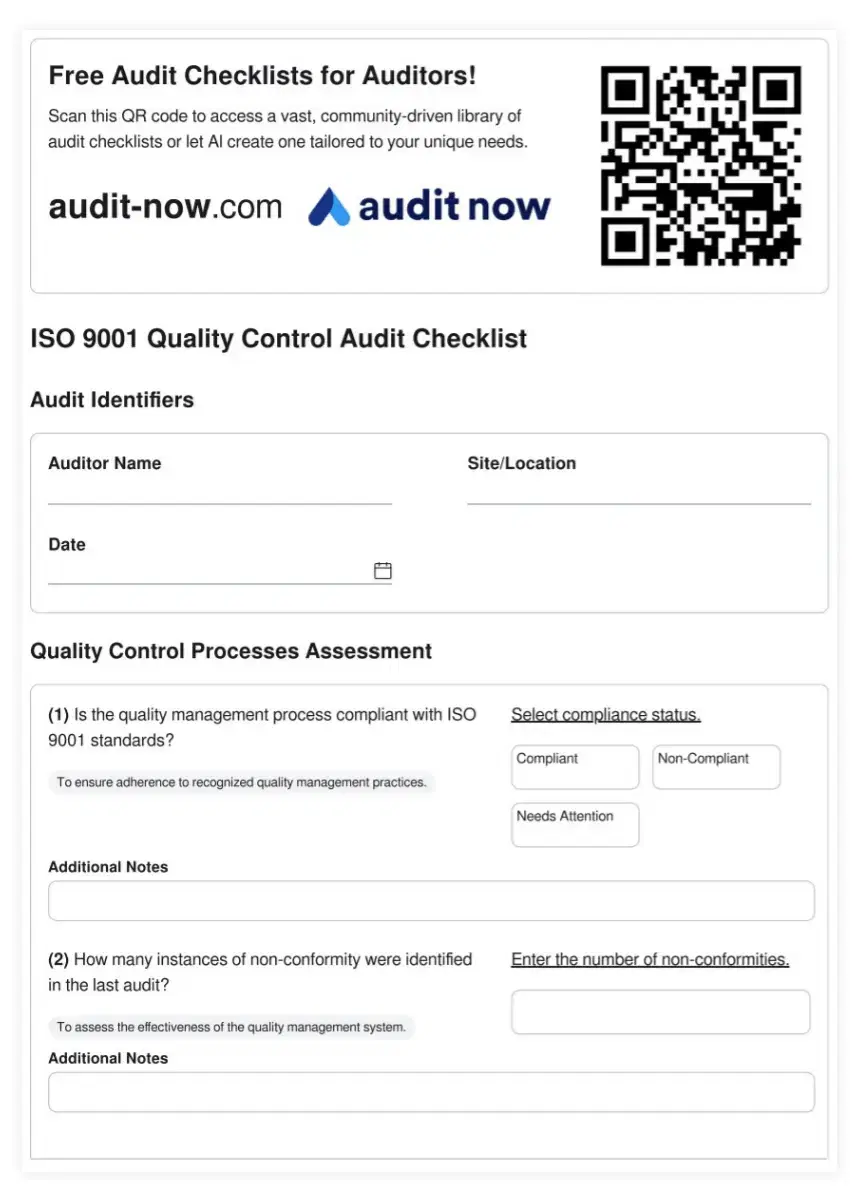Quality Assurance Engineer Checklists

Featured Checklist

ISO 9001 Quality Assurance Checklist
The ISO 9001 Quality Assurance Checklist is an essential tool for organizations striving to maintain and improve their quality management systems. This comprehensive checklist aligns with the ISO 9001:2015 standard, ensuring that all critical aspects of quality assurance are addressed systematically. By implementing this checklist, businesses can identify gaps in their processes, enhance customer satisfaction, and drive continuous improvement. It serves as a valuable resource for internal audits, helping organizations prepare for certification audits and maintain compliance with international quality standards.
Quality Assurance Engineer Operational Overview
Quality Assurance Engineers face many challenges in their day-to-day work. They must ensure software meets high standards while juggling tight deadlines, changing requirements, and complex systems. Balancing thorough testing with quick delivery is often tricky.
These challenges directly impact business success. Poor quality can lead to unhappy users, lost customers, and damaged reputation. On the flip side, effective QA practices result in reliable products, increased user satisfaction, and stronger market position.
Quality management is at the heart of a QA Engineer's role. It involves creating and following processes that catch bugs early, improve code quality, and maintain consistent standards. As we'll see, auditing plays a key part in achieving these goals.
Core Audit Requirements & Checklist Importance
Audits are vital for a Quality Assurance Engineer. They help identify gaps in processes, ensure compliance with standards, and drive continuous improvement. Key audit components include reviewing test plans, examining bug tracking systems, and assessing code review practices.
Systematic checklists are powerful tools in the audit process. They provide a structured approach, ensuring no critical steps are missed. Checklists also standardize audits across teams and projects, making results more consistent and comparable.
Compliance is another crucial aspect of QA audits. Depending on the industry, there may be specific regulatory requirements to meet. Checklists help track and document compliance efforts, providing evidence during official audits or inspections.
- Test Coverage: Verify all features and use cases are tested
- Documentation: Check for up-to-date requirements and test plans
- Defect Management: Review bug tracking and resolution processes
- Performance Testing: Ensure system meets speed and scalability targets
- Security Testing: Confirm proper security measures are in place
Personalize Your Workflow
Tailor your checklists to match your team's daily processes. Start customizing now!
Customize
Automated Testing Challenges and Best Practices
Automated testing is a key focus for many Quality Assurance Engineers. It offers faster feedback and more consistent results. However, it comes with its own set of challenges. Test maintenance can become a burden as the codebase grows and changes. Flaky tests that sometimes pass and sometimes fail can erode trust in the test suite.
To overcome these hurdles, QA Engineers should follow best practices. This includes writing modular, reusable test code and using stable test data. Implementing proper test isolation helps prevent tests from interfering with each other. Regular review and cleanup of the test suite is also crucial to keep it manageable and effective.
Quality control in automated testing involves monitoring test coverage, execution times, and failure rates. Tools like test runners and continuous integration systems help track these metrics. By keeping a close eye on these indicators, QA Engineers can ensure their automated tests remain valuable and reliable.
Continuous Integration and Delivery Optimization
Process optimization in QA often centers around Continuous Integration and Delivery (CI/CD) pipelines. These automated workflows help catch issues early and speed up releases. QA Engineers play a crucial role in setting up and maintaining these pipelines. This includes configuring automated tests, code quality checks, and deployment scripts.
Risk management in CI/CD involves identifying potential points of failure. For example, a QA Engineer might set up monitoring for long-running tests that could delay builds. They might also implement safeguards to prevent faulty code from being deployed to production environments.
Key performance metrics for CI/CD include build success rate, test pass rate, and time to deploy. By tracking these numbers, QA Engineers can spot trends and make data-driven improvements. For instance, if build times are increasing, they might investigate ways to parallelize tests or optimize the build process.
Digital Transformation with Audit Now
Audit Now offers powerful AI-driven checklists tailored for Quality Assurance Engineers. These smart tools adapt to your specific needs, suggesting relevant items based on your project and industry. Real-time collaboration features allow team members to work together seamlessly, even when distributed across different locations.
Our extensive template library covers a wide range of QA scenarios. From test plan reviews to security audits, you'll find ready-to-use checklists that save time and ensure thoroughness. Start improving your QA processes today with our digital audit solutions.
Ready to elevate your Quality Assurance practices? Explore our QA Engineer templates at audit-now.com/templates/. For custom checklists tailored to your needs, try our AI checklist generator at audit-now.com/generate-ai-checklist/.
Most Popular 10 Quality Assurance Engineer Checklists
DO-254 Hardware Design Data Package Checklist
DO-254 Hardware Tool Qualification Checklist
Aircraft Fuel System Safety Inspection Checklist
AS9100 Design and Development Audit Checklist
AS9100 Configuration Management Audit Checklist